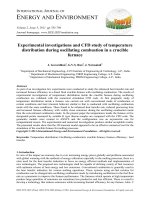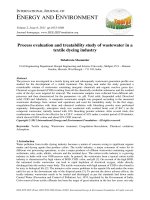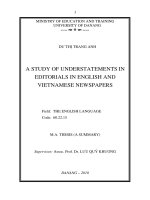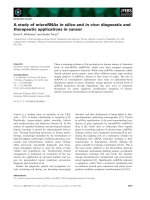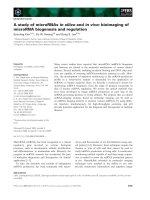Serodetection and bacteriological study of Brucellosis in goats
Bạn đang xem bản rút gọn của tài liệu. Xem và tải ngay bản đầy đủ của tài liệu tại đây (236.79 KB, 9 trang )
Int.J.Curr.Microbiol.App.Sci (2019) 8(9): 3032-3040
International Journal of Current Microbiology and Applied Sciences
ISSN: 2319-7706 Volume 8 Number 09 (2019)
Journal homepage:
Original Research Article
/>
Serodetection and Bacteriological Study of Brucellosis in Goats
Anujna1*, Yamini Verma1, Madhu Swamy1, Anju Nayak2 and Amita Dubey1
1
Department of Pathology, College of Veterinary Science and Animal Husbandry,
NDVSU, Jabalpur, Madhya Pradesh –482001, India
2
Department of Microbiology, College of Veterinary Science and Animal Husbandry,
NDVSU, Jabalpur, Madhya Pradesh –482001, India
*Corresponding author
ABSTRACT
Keywords
ABST, Brucella,
MRT, isolation,
RBPT, STAT
Article Info
Accepted:
04 August 2019
Available Online:
10 September 2019
The present study was conducted with the aim to record seroprevalence and
microbiological studies in serum and milk samples and vaginal swabs
respectively, of brucellosis in goats. A total of 110 serum samples, 13 milk
samples and 50 vaginal swabs were collected randomly from various
organized and unorganized goat farms, regardless of breed and age (1year-9
years) of goats. Out of total 110 serum samples examined, 06 (05.45%) and
04 (03.63%) samples were found to be positive by Rose Bengal Plate Test
and Standard Tube Agglutination Test, respectively. Out of 13 milk
samples 04 (30.76%) were found positive by Milk Ring Test. Vaginal
swabs were inoculated for isolation and identification of Brucella
organisms in selective media. Three isolates (06.66%) were obtained and
confirmed as Brucella spp by morphological and biochemical characters.
The results show the occurrence of brucellosis in the studied area and are of
public health significance.
Introduction
Brucellosis is a chronic infectious disease of
livestock, rodents, marine animals and human
beings and is caused by facultative
intracellular coccobacilli of genus Brucella.
Caprine brucellosis caused by Brucella
melitensis is most pathogenic for humans and
the second most important zoonotic disease
after rabies (Saxena et al., 2018). In goats
clinically the disease is characterised by
chronic infections leading to abortion,
retention of placenta, metritis, subclinical
mastitis, hygroma, orchitis, epididymitis and
infertility or sterility forcing the owners to cull
the animals and thus poses a serious threat to
the livestock economy (Gogoi et al., 2017).
The conventional assays such as Rose Bengal
Plate Test (RBPT), Milk Ring Test (MRT),
Serum Agglutination Test (SAT), indirect
Enzyme Linked Immunosorbent Assay
3032
Int.J.Curr.Microbiol.App.Sci (2019) 8(9): 3032-3040
(iELISA) etc. is widely used in various
combinations for the diagnosis of brucellosis.
However, as unequivocal diagnosis is by
bacteriological identifications of the causative
agent, for confirmation of brucellosis,
isolation and culture of Brucella organisms is
the gold standard test (Saxena et al., 2018).
The present study was carried out to determine
the prevalence of Brucella antibodies in goats
and isolation, identification and biochemical
characterization of organisms from goats
having a history of abortion and vaginal
discharge.
Materials and Methods
Samples
The samples were collected randomly from
female goats regardless of breed and age
(1year- 9 years) belonging to various
organized and unorganized goat farms, in and
around Jabalpur, Madhya Pradesh, India.
Approximately 5 ml of blood was collected
aseptically from jugular vein of 50 goats with
history of abortion (20) and vaginal discharge
(30) whereas, 60 samples were collected
randomly without any history of reproductive
disorder and serum was separated from these
blood samples. All the collected serum
samples were tested for Brucella antibodies by
RBPT and STAT. For MRT, milk samples
were collected aseptically from 13 goats with
a history of abortion. Vaginal swabs from 50
live goats with the history of abortion (20) and
vaginal discharge (30) were collected
aseptically using transport swabs in Amies
medium with charcoal (HiMedia) and
processed for bacteriological isolation.
Rose Bengal Plate Test
The RBPT antigen was procured from
Biological
Products
Division,
Indian
Veterinary Research Institute, Izatnagar.
Twenty five microlitre of serum was taken on
a glass slide. Twenty five microlitre of RBPT
coloured antigen was added. The antigen and
serum were mixed thoroughly using sterile
toothpick and the slide was rotated for four
minutes and the results were read
immediately. Definite visible clumping was
considered as positive, whereas no clumping/
agglutination was considered as negative
(Singh et al., 2016).
Standard Tube Agglutination Test
The
plain
Brucella
abortus
Serum
Agglutination Test (SAT) antigen was
procured from Biological Products Division,
Indian Veterinary Research Institute (IVRI),
Izatnagar. Serial dilution upto ten tubes were
made with 05% phenol saline and eleventh
tube was kept as control without adding serum
and the tubes were placed in a rack. 0 The
tube rack was also shaken manually and was
incubated at 37°C for 24 hours Positive
reaction was determined by observing a clear
supernatant with matt formation at the bottom.
Negative reaction was determined by turbid
supernatant with button formation at the
bottom. The highest dilution showing
agglutination was considered as end titre.
Tubes showing agglutination at 1:20 dilution
and above or antibody titre of 40I.U. and
above were considered as positive.
Milk Ring Test
Abortus Bang Ring / MRT coloured antigen
was obtained from Biological Products
Division, Indian Veterinary Research Institute
(IVRI), Izatnagar. One ml of milk was taken
in two test tubes each and 30-40 μl (1-2 drops)
of antigen was added to one tube and mixed
well. The tubes were incubated at 37°C for 1
hour (Khan et al., 2018). Milk was completely
white and cream layer was coloured - high
positive (+++). Milk was slightly coloured and
cream layer was distinctly coloured- positive
3033
Int.J.Curr.Microbiol.App.Sci (2019) 8(9): 3032-3040
(++). Milk was distinctly coloured and cream
layer was white- negative.
Bacterial isolation, identification
biochemical characterization
and
Each swab was separately inoculated into
Brucella broth aseptically for enrichment of
the organisms and incubated at 37°C for 24
hours. The broth cultures were streaked on
Brucella Agar Medium (BAM) plates (with
Hemin and Vitamin K) with 5 per cent v/v
sterile inactivated horse serum (HiMedia) and
rehydrated contents of Brucella selective
supplement in duplicate. One plate was
incubated aerobically in incubator at 37°C and
the other plate was incubated at 37°C under 5
per cent CO2 in an anaerobic candle jar and
incubated at 37°C for minimum of 72-96
hours (03-04 days). The plates were observed
at every 24 hours for the growth. The
suspected colonies of Brucella were picked
from Brucella agar medium and were further
inoculated on MacConkey agar and blood agar
and incubated at 37°C for 72 hours for their
cultural characteristics. The organisms were
identified by colony morphology like colour,
shape, size, surface, edges.
The isolates were confirmed by staining
characters with Gram’s and modified ZiehlNeelsen (MZN) staining and agglutination
with Brucella abortus antiserum biochemical
tests like catalase, oxidase, urease, nitrate
reduction and growth in the presence of dyes
{(thionin 20μg/ml (1:50,000) and basic
fuchsin 20μg/ml (1:50,000)} (Alton et al.,
1988).
The isolates were tested for their sensitivity
pattern against 07 antibiotics. Antibiotics discs
(HiMedia): Rifampicin (RIF, 30 mcg),
Ceftriaxone (CTR, 30 mcg), Enrofloxacin
(EX, 10 mcg), Gentamicin (GEN, 10 mcg),
Streptomycin (S, 10 mcg), Oxytetracycline (O,
30 mcg) and Penicillin (P, 10 units) were used.
Results and Discussion
Seroprevalence of Brucella antibodies in
serum and milk samples
The prevalence of Brucella antibodies in
female goats was found to be 5.45% (06/110)
comprising of 20% (4/20) cases of abortion
and 06.6% (2/30) cases of vaginal discharge
by RBPT, 3.63% (04/110) comprising of
15.00% (3/20) cases of abortion and 03.33%
(01/30) cases of vaginal discharge by STAT
and 30.76% (04/13) cases of abortion by
MRT. Four samples were positive by both
RBPT and STAT. Three of the STAT positive
samples showed titres of 40 I.U/ml at 1:20
dilution and one sample showed a titre of 80
I.U/ml at 1:40 dilution.
The prevalence was found to be higher in
goats belonging to the age group of 3-5 years
(Table 1) and goats of unorganized farms as
compared to the organized farms (Table 2).
Highest percentage of Brucella abortus
positive reactors was observed among the
goats having a history of second day to two
months post abortion (Table 3).
Bacterial isolation from vaginal swabs
A total of 03 isolates (02- abortion cases, 01vaginal discharge) were obtained from 50
vaginal swabs collected and were confirmed
as Brucella spp.
Identification of Brucella spp
All the isolates were identified as Brucella spp
based on colony morphology with typical
characteristics as small, pinpoint, glistening,
smooth and circular colonies on Brucella agar
with hemin and vitamin K1, no growth on
MacConkey agar and non-hemolytic colonies
on blood agar. The organisms were able to
grow aerobically without CO2.
3034
Int.J.Curr.Microbiol.App.Sci (2019) 8(9): 3032-3040
Smears from all the isolates revealed pale red
coloured coccobacillli by Gram’s staining and
pink coloured coccobacilli by MZN staining.
The isolates showed moderate agglutination
with Brucella abortus antiserum. The isolates
were positive for catalase, oxidase, urease,
nitrate reduction and growth on Tryptic Soya
agar with thionin and basic fuchsin dyes 20
μg/ml concentrations as listed in table 4.
In the present study all the isolates were
variably sensitivity to antimicrobial drugs
tested. All the isolates (100%) were sensitive
to rifampicin, ceftriaxone and enrofloxacin
whereas all the isolates (100%) were resistant
to oxytetracyclin and penicillin. While 02
isolates (66.66%) were sensitive and 01 isolate
(33.33%) were resistant to gentamicin and 01
(33.33%) of the isolates were sensitive
whereas 02 isolates (66.66%) were resistant to
streptomycin.
The findings in the present study by RBPT has
close association with the findings of Priya et
al., (2010), Akbarmehr and Ghiyamirad
(2011) and Reddy et al., (2014) as they
reported 05.70%, 05.00% and 05.15%
prevalence among goats. A higher prevalence
was reported by Aworh et al., (2017) as
19.60% from Nigeria, Albert et al., (2018) as
14.80%, by Saxena et al., (2017) as 07.30%
from Punjab and by Kanani et al., (2018) as
15.99% from Gujarat.
The prevalence of Brucella antibodies by
STAT (03.63%) observed in the present study
is corroborated with the findings of Sharma et
al., (2017) who reported a prevalence of
03.42% by STAT in goats in and around
border areas of Jammu, India. Higher
prevalence of brucellosis in goats by STAT as
06.53% from Punjab by Saxena et al., (2017),
as 10% from Gujarat by Padher et al., (2017)
05.86% from Sudan by Mohamed et al.,
(2018) and 04.45% from China by Rahman et
al., (2019). Lower prevalence rates, 02.00%
and 01.45% was reported by Uddin et al.,
(2007) and Gogoi et al., (2017), respectively
from Bangladesh and Assam.
A lower prevalence was observed in goat milk
as 26.00%, 09.16%, 06.00%, 11.50% and
11.67% by Kaltungo et al., (2013), Najum
(2014), Khan et al., (2018), Al – Mashhadany
(2018) and Rahman et al., (2019) respectively
by MRT.
Of the 110 goat serum samples, 06 (05.45%)
were found positive by RBPT, of these 04
(03.63%) were also positive by STAT. More
number of samples was positive by RBPT
than STAT. However as compared to RBPT,
STAT is more reliable and accurate as it
involves serial dilution which gives both
qualitative and quantitative results about the
titre of the antibodies againt Brucella abortus
SAT antigen (Din et al., 2013).
Table.1 Seroprevalence of Brucella antibodies in goats of different age groups
Age
group
1-2 yrs
3-5 yrs
6-9 yrs
Serum
RBPT
No.
No.
Per cent
collected positive prevalence
61
02
03.27
41
04
09.75
08
00
00.00
STAT
No.
Per cent
positive prevalence
01
01.63
03
07.30
00
00.00
3035
No.
Collected
09
03
01
Milk
MRT
No.
positive
02
02
00
Per cent
prevalence
22.22
66.66
00.00
Int.J.Curr.Microbiol.App.Sci (2019) 8(9): 3032-3040
Table.2 Sero-prevalence of Brucella antibodies in goats of organized and
Unorganized goat farms
Farm types
Organized
Unorganized
No.
collected
40
70
Serum
RBPT
No.
Per cent
Positive prevalence
01
02.50
05
07.14
No.
positive
01
03
STAT
Per cent
prevalence
02.50
04.28
Milk
MRT
No.
positive
01
03
No.
collected
04
09
Per cent
prevalence
25.00
44.44
Table.3 Reproductive disorders in positive reactors
Reproductive
disorder
Abortion
Vaginal
discharge
Serum
RBPT
STAT
No.
No.
Per
No.
Per
collected Positive cent positive
cent
20
04
20.00
03
15.00
30
02
06.66
01
03.33
Milk
MRT
No.
No.
collected positive
13
04
00
00
Per
cent
30.76
00.00
Table.4 Cultural, biochemical and serological characteristics of isolates
S.
No.
Name of the test
01.
Isolates
L1
L2
L3
U1
U2
U3
F
CO2 requirement
-
-
-
-
-
-
-
02.
Growth on MacConkey
-
-
-
-
-
-
-
03.
Hemolysis on blood agar
NH
NH
NH
NH
NH
NH
NH
04.
M
M
M
M
M
M
M
05.
Agglutination with positive
serum
Catalase test
+
+
+
+
+
+
+
06.
Oxidase test
+
+
+
+
+
+
+
07.
Urease test
+
+
+
+
+
+
+
08.
Nitrate reduction test
+
+
+
+
+
+
+
09.
Methyl Red
-
-
-
-
-
-
-
10.
Voges-Proskauer
-
-
-
-
-
-
-
11.
Indole production
-
-
-
-
-
-
-
12.
H2S production
-
-
-
-
-
-
-
+= Positive; - = Negative; NH= Non hemolytic colonies; M= Moderate agglutination
Isolates L1, L2, L3- vaginal swabs from live animals; U1, U2, U3- uterine swabs; F- stomach content swab from
foetus.
3036
Int.J.Curr.Microbiol.App.Sci (2019) 8(9): 3032-3040
Higher prevalence of the disease as detected
by MRT, could be due to less number of
samples screened or because of false positive
reactions that can occur in samples containing
abnormal milk (such as colostrum) as the
samples were collected from goats after
abortion or infection with other cross reacting
bacteria
like
Yersinia
enterocolitica,
Escherichia coli, Francisella tularensis,
Salmonella etc. (Albert et al., 2018).
A higher prevalence of Brucella antibodies in
goats was observed in unorganized farms as
compared to organized farms. This could be
due to better managemental practices like
routine screening of goats for brucellosis in
organized farms.
The present study showed that goats of higher
age group are more affected than young goats.
With advancing age the reproductive organs
are more functional, hence, adult goats are
more susceptible to brucellosis. Tegegn et al.,
(2016) stated that brucellosis is mainly a
disease of sexually mature and pregnant
animals which, may be due to the presence of
erythritol that stimulates the growth and
multiplication of Brucella organisms.
The present findings are in agreement with
Radostits et al., (2007) and Jones et al.,
(1997) who stated that with time duration of
pregnancy, production of erythritol increases,
which promotes the growth of Brucella
organisms as a result there is increased level
of antibodies in the serum. Moreover,
proliferation of organisms in trophoblasts
leads to placentitis, infection of the foetus and
abortion in the late stage of pregnancy.
The 03 isolates obtained from different
samples in the present study were confirmed
as Brucella species by cultural, morphological
and biochemical tests similar to earlier reports
by Alton et al., (1988) and Koneman et al.,
(1997). Babuhai (2012) also obtained 07
isolates (02 from vaginal swabs and 05 from
tissue samples) from goat samples. Sumathi et
al., (2018) isolated the organisms from 05
samples and identified them as Brucella,
based on colony morphology, Gram’s
reaction, acriflavine test and agglutination
tests which can be compared to the present
study. In another study by Tekle et al., (2019)
of the 64 samples cultured, eight samples
(five vaginal swabs and three milk) were
positive for Brucella species based on colony
morphology, growth characteristics, modified
acid fast staining and biochemical tests
results.
In the present study only 03 isolates could be
obtained from the samples with reproductive
disorder which could be attributed to the
fastidious nature of Brucella species, it could
also be influenced by stage of the disease and
quantity of bacteria shed in the uterine
discharge which determines the amount of
viable organisms in the sample for culture
(Tekle et al., 2019). Also the low culture
positivity from the present study may be
because the causes of reproductive problems
could be by any etiology other than Brucella.
Morales-Estrada et al., (2016) reported that
09 of the 10 isolates were sensitive to
rifampicin which is comparable to the present
study. In another study by Nagal et al., (1994)
it was reported that Brucella melitensis
biotype III was sensitive to tetracycline and
gentamicin but similar to the present study
resistance to penicillin G and streptomycin
was observed. In contrast to the present study
Ghodsara et al., (2011) reported that 100 per
cent of the isolates were sensitive to
penicillin-G,
streptomycin,
gentamicin,
oxytetracycline, whereas 60 per cent to
rifampicin and 40 per cent isolates were found
sensitive to ceftriaxone.
Seroprevalence against Brucella abortus in
goats was determined as 03.63 per cent by
Standard Tube Agglutination Test. The
3037
Int.J.Curr.Microbiol.App.Sci (2019) 8(9): 3032-3040
prevalence was found to be higher in goats
belonging to the in unorganized farms as
compared to the organized farms. A higher
prevalence was observed age group of 3-5
years. 03/50 isolates of Brucella spp were
recovered from vaginal swabs. All the isolates
had typical colony characterisctics of Brucella
and showed MZN positive staining, catalase,
urease, oxidase and nitrate reduction positive.
Acknowledgement
The authors are highly thankful to the Dean,
College of Veterinary science and A.H.
Jabalpur for financial assistance and research
facilities to conduct this research work.
References
Akbarmehr, J. and Ghiyamirad, M. 2011.
Serological survey of brucellosis in
livestock animals in Sarab City (East
Azarbayjan province), Iran. African
Journal
of
Microbiology
Research. 5(10): 1220-1223.
Albert, I.P., Kato, C.D., Ikwap, K., Kakooza,
S., Ngolobe, B., Ndoboli, D. and
Tumwine, G. 2018. Comparison of rose
Bengal plate test, serum agglutination
test, and indirect enzyme-linked
immunosorbent assay in brucellosis
detection for human and goat samples.
International Journal of One Health. 4:
35-39.
Al–Mashhadany, D.A. 2018. The utility of
MRT to screen brucellosis among ewe
and nanny goats milk in Erbil
Governorate/Kurdistan
Region/Iraq.
International Journal of Biology,
Pharmacy and Allied Sciences. 7(9):
1786-1802.
Alton, G. G., Jones, L. M., Angus, R. D.,
Verger, J. M. 1988 Techniques for the
Brucellosis Laboratory, first ed. Paris:
Institute Nationale de la Recherche
Scientifique. pp. 25-59.
Aworh, M.K., Okolocha, E.C., Awosanya,
E.J. and Fasina, F.O. 2017. Seroprevalence and intrinsic factors
associated with Brucella infection in
food animals slaughtered at abattoirs in
Abuja,
Nigeria. BMC
Research
Notes. 10(1): 499.
Babuhai, S.M. 2012. Detection of brucellosis
in sheep and goats in Gujarat state by
cultural isolation, serological tests and
molecular techniques. M.V.Sc thesis,
Anand Agricultural University, Gujarat,
India.
Din, A.M.U., Khan, S.A., Ahmad, I., Rind,
R., Hussain, T., Shahid, M. and Ahmed,
S. 2013. A study on the seroprevalence
of brucellosis in human and goat
populations of district Bhimber, Azad
Jammu and Kashmir. Journal of Animal
and Plant Science. 23: 113-118.
Ghodasara, S.N., Roy, A. and Bhanderi, B.B.
2011. In vitro antibiotic sensitivity
pattern of Brucella spp. isolated from
reproductive
disorders
of
animals. Buffalo Bulleti, 30(3):188-194.
Gogoi, S.B., Hussain, P., Sarma, P.C., Gogoi,
P. and Islam, M. 2017. Prevalence of
brucellosis in goat in Assam, India.
International Journal of Chemical
Studies. 5(4): 1176-1179.
Jones, T.C., Hunt, R.D., King, N.W. 1997.
Veterinary Pathology, first ed. Williams
and Wilkins. Baltimore, pp. 444-447.
Kaltungo, B.Y., Saidu, S.N.A., Sackey,
A.K.B. and Kazeem, H.M. 2013.
Seroprevalence of brucellosis in milk of
sheep and goats in Kaduna north
senatorial district of Kaduna State,
Nigeria. International Journal of Dairy
Science. 8(2): 58-64.
Kanani, A., Dabhi, S., Patel, Y., Chandra, V.,
Vinodh Kumar, O.R, and Shome, R.
2018. Seroprevalence of brucellosis in
small ruminants in organized and
unorganized sectors of Gujarat state,
3038
Int.J.Curr.Microbiol.App.Sci (2019) 8(9): 3032-3040
India, Veterinary World. 11(8): 10301036.
Khan, T.I., Ehtisham-ul-Haque, S., Waheed,
U., Khan, I., Younus, M. and Ali, S.
2018. Milk indirect-ELISA and milk
ring test for screening of brucellosis in
buffaloes, goats and bulk tank milk
samples collected from two districts of
Punjab, Pakistan. Pakistan Veterinary
Journal. 38(1): 105-108.
Koneman, E.W., Allen, S.D., Janda, W.M.,
Schreckenberger, P.C. and Winn, W.C.
1997. Diagnostic Microbiology, fifth
ed.
Lippincott-Raven
Publishers.
Philadelphia, pp. 431–436.
Mohamed, E.M., Mohamed Elfadil, A.A., ElSanousi, E.M., Ibrahaem, H.H.,
Mohamed-Noor, S.E., Abdalla, M.A.
and Shuaib, Y.A. 2018. Seroprevalence
and risk factors of caprine brucellosis in
Khartoum state, Sudan. Veterinary
World. 11(4): 511-518.
Morales-Estrada, A.I., Hernández-Castro, R.,
López-Merino, A., Singh-Bedi, J. and
Contreras-Rodríguez,
A.
2016.
Isolation,
identification
and
antimicrobial susceptibility of Brucella
spp. cultured from cows and goats
manure in Mexico. Archivos de
Medicina Veterinaria. 48(2): 231-235.
Nagal, K.B., Katoch, R.C., Sharma, M.,
Sambyal, D.S. and Kumar, N. 1994.
Brucella melitensis abortions in a dairy
herd. Indian Journal of Animal Science.
64: 132-134.
Najum, A.A. 2014. Diagnosis of Brucella
melitensis infection in goats’ milk by
milk ring test and polymerase chain
reaction. Magazine
of
Al-Kufa
University for Biology. 6(1): 198-201.
Padher, R.R., Nayak, J.B., Brahmbhatt, M.N.
and
Mathakiya,
R.A.
2017.
Comparative sensitivity and specificity
of various serological tests for detection
of
brucellosis
in
small
ruminants. International Journal of
Current Microbiology and Applied
Sciences. 6(5): 2090-2099.
Patel, K.B., Patel, S.I., Chauhan, H.C.,
Thakor, A.K., Pandor, B.R., Chaudhari,
S.S., Chauhan, P.H. and Chandel, B.S.
2017.
Comparative
efficacy
of
serological tests for detection of
Brucella antibodies in sheep and
goats. Journal
of
Animal
Research. 7(6): 1083-1087.
Priya, P.M., Baburaj, N.K., Kiran, N. and
Rajan, S. 2010. Brucellosis in Wayanad
tribal goat population: A preliminary
serological survey. Journal of Advanced
Laboratory Research in Biology. 1(2):
101-103.
Radostits O.M, Gay, C.C, Hinchcliff, K.W
and Constable, P.D. 2007. Veterinary
Medicine: A Textbook of the diseases
of cattle, sheep, pigs, goats and horses,
tenthh ed. WB Saunders Company.
Edinburgh, pp. 963-994.
Rahman, S.U., Zhu, L., Cao, L., Zhang, Y.,
Chu, X., Feng, S., Li, Y., Wu, J. and
Wang, X. 2019. Prevalence of caprine
brucellosis in Anhui province, China,
Veterinary World. 12(4): 558-564.
Saxena, N., Singh, B.B. and Saxena H.M.
2018. Brucellosis in sheep and goats
and its serodiagnosis and epidemiology.
International Journal of Current
Microbiology and Applied Sciences.
7(1): 1848-1877.
Saxena, N., Singh, B.B., Gill, J.P.S. and
Aulakh, R.S. 2017. Frequency of
occurance of brucellosis in goats in
Ludhiana district of Punjab state of
India. Microbiology Research Journal
International. 21(6): 01-07.
Sharma, V., Sharma, H.K., Ganguly, S.,
Berian, S. and Malik, M.A. 2017.
Seroprevalence studies of brucellosis
among goats using different serological
tests. Journal of Entomology and
Zoological Studies. 5(2): 1512-1516.
3039
Int.J.Curr.Microbiol.App.Sci (2019) 8(9): 3032-3040
Singh, N., Patel, R., Singh, P. and Patel, N.
2016. Seroprevalence of brucellosis and
comparison of serum biochemical
parameters between infected and
healthy goats. International Journal of
Agriculture Sciences. 8(3): 988-990.
Sumathi,
B.R.,
Veeregowda,
B.M.,
Byregowda, S.M., Rathnamma, D.,
Isloor,
S.,
Shome,
R.
and
Narayanaswamy, H.D. 2018. Isolation,
identification
and
molecular
confirmation of Brucella melitensis
from ovine and caprine flocks in
Karnataka, India. International Journal
of Current Microbiology and Applied
Sciences. 7(5): 3224-3231.
Tegegn, A.H., Feleke, A., Adugna, W. and
Melaku, S.K. 2016. Small ruminant
brucellosis and public health awareness
in two districts of afar region, Ethiopia.
Journal of Veterinary Science and
Technology. 7(4): 01-02.
Tekle, M., Legesse, M., Edao, B.M., Ameni,
G. and Mamo, G. 2019. Isolation and
identification of Brucella melitensis
using bacteriological and molecular
tools from aborted goats in the Afar
region of north-eastern Ethiopia. BMC
Microbiology. 19(1): 108-114.
Uddin, M.J., Rahman, M.S. and Akter, S.H.
2007. Brucellosis of goats (Capra
hircus) in Bangladesh. Journal of the
Bangladesh Agricultural University.
5(2): 275-282.
How to cite this article:
Anujna, Yamini Verma, Madhu Swamy, Anju Nayak and Amita Dubey. 2019. Serodetection
and Bacteriological Study of Brucellosis in Goats. Int.J.Curr.Microbiol.App.Sci. 8(09): 30323040. doi: />
3040
